When did artists first become collectors? Visual artists have long gathered art and other objects to serve as potential models for their own work. With the advent of prints in the fifteenth century, it became far easier to acquire a diverse range of stylistic and iconographic sources. Obviously, a work of art could be both a model and a collectible object prized for its aesthetic features. Renaissance artists did collect: Giorgio Vasari (1511–74), for example, amassed an impressive set of drawings by other Italian masters.Footnote 1 Unfortunately, little information survives concerning the tastes and collecting habits of German artists of the late fifteenth and early sixteenth centuries. Mathias Gothart Neithart, better known as Grünewald (ca. 1475/80–1528), left a few Lutheran pamphlets, a length of fine Netherlandish cloth, and some art supplies when he died in 1528, but left no other art.Footnote 2 Albrecht Altdorfer (ca. 1480–1538) possessed a few paintings, including one by Albrecht Dürer (1471–1528), some antique coins, and nineteen books, among other items.Footnote 3 Sebald Beham (1500–50) upon his death in 1550 left a collection of 1,200 antique coins and small cast sculptures that may have come to him from his brother Barthel (1502–40), who had visited Italy.Footnote 4 Otherwise, there is no substantive documentation for masters like Hans Baldung Grien (1484/85–1545), Hans Burgkmair (1473–1531), Lucas Cranach the Elder (1472–1553), Hans Holbein the Younger (1497/98–1543), and Tilman Riemenschneider (ca. 1460–1531).
There is one major exception: Albrecht Dürer. Thanks to extant letters; the journal of his trip to the Netherlands in 1520–21; his theoretical texts; inscriptions added to paintings, drawings, and books; as well as a variety of other sources, we are better informed about his life, his thoughts, and his tastes than about all of his peers combined. Writing shortly after returning from his second trip to Venice in 1507, the Nuremberg master remarked, “I possess fairly good household furniture, good clothes, some good tin vessels, good materials for my work, bedding, chests and cupboards and good colors worth 100 florins Rhenish.”Footnote 5 In actuality, as we shall see, he soon would own far more noteworthy items. He died a wealthy man.Footnote 6 This short essay addresses Dürer as a collector as well as some of the issues this topic raises. Although we lack knowledge of most of what he acquired during the early decades of his career, there is sufficient material to piece together a general picture of his collection. I use the term collector rather than art collector for reasons that will become clear.
ALBERTVS DVRER PICTOR GERMANICVS (“Albrecht Dürer the German Painter”) reads the inscription on Hans Schwarz's (1492–after 1521) portrait medal (fig. 1). Some time in September 1520 Dürer wrote in his Netherlandish journal, “I sent Hans Schwarz 2 fl. in gold for my picture, in a letter by the Antwerp Fuggers to Augsburg.”Footnote 7 He is portrayed in profile with his long hair flowing over his fur-trimmed cloak. Dürer first met Schwarz, Germany's first great medallist, or at least admired his craft, during the Diet of Augsburg in 1518. Schwarz resided briefly in Nuremberg in 1519, before an altercation prompted his return to his native Augsburg. He first sketched Dürer's portrait, now lost, then carved a wooden model (today in Braunschweig, Herzog Anton Ulrich–Museum), and finally cast impressions of the medal in silver. Dürer did not stipulate whether he received one or more copies of the medal while in Antwerp. Numerous impressions exist, though many of these could have been cast after Dürer's return to Nuremberg. Surprisingly, Schwarz's medal is the sole documented commission by Dürer.
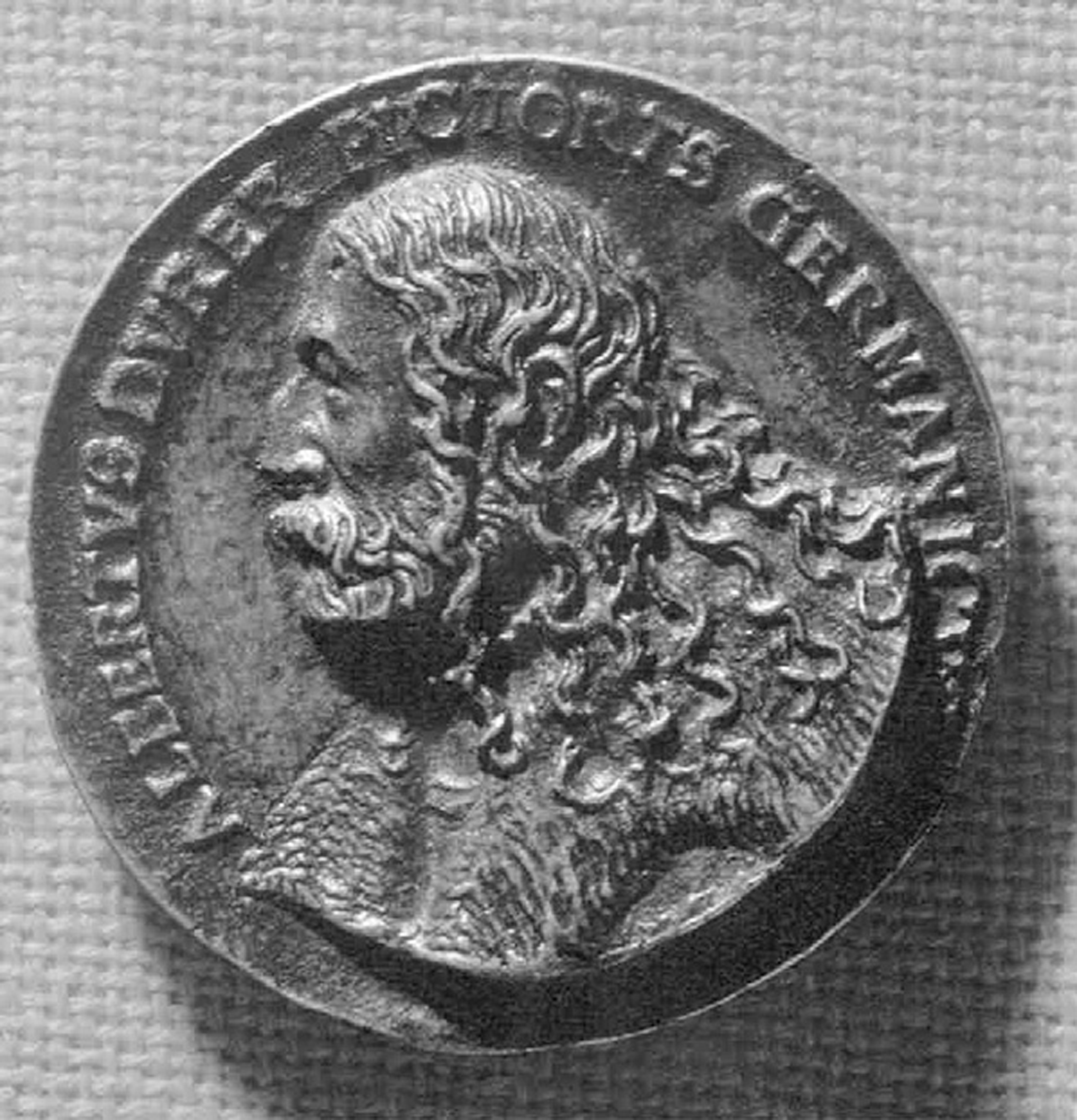
Figure 1 Hans Schwarz. Portrait of Albrecht Dürer, 1520. Medal. Nuremberg, Germanisches Nationalmuseum.
In his biography of Raphael (1483–1520), Giorgio Vasari reports that Dürer sent Raphael a self-portrait, most likely a watercolor on fine canvas so the painting could be viewed from the front and the back.Footnote 8 Raphael reciprocated by sending Dürer a red chalk drawing of three nude men (fig. 2) and perhaps additional sketches. The attribution of this drawing to Raphael, now generally accepted, and its relation to his paintings in the Vatican Stanze do not concern us here. At right on the drawing in Dürer's handwriting is inscribed, “1515 Raphael of Urbino, who was held in high esteem by the pope, sent this picture of nudes to Nuremberg for Albrecht Dürer in order to show him his skill.”Footnote 9 Dürer frequently annotated works of art in his possession. Here he proudly registers that Raphael, artist to Pope Leo X (r. 1513–21), sent him a virtuoso sketch to display his skill. Raphael presented Dürer with the perfect gift, since in the 1510s the Nuremberg master was immersed in his theoretical studies of the human body and its proportions.Footnote 10 Raphael's figures were unlike any German nudes at this time. In his Vier Bücher von menschlicher Proportion (Four Books on Human Proportions), published posthumously in 1528, Dürer expresses his admiration for the creative hand, that is, for the master who in a few strokes could say much more than another artist who might labor a year.Footnote 11 By adding the inscription, which was likely contemporary with the receipt of the drawing, the artist goes beyond mere admiration. Dürer consciously establishes his direct link and creative kinship with Raphael. Since he knows who authored and sent the drawing to him, Dürer intentionally documents this story for others, audiences both contemporary and future.
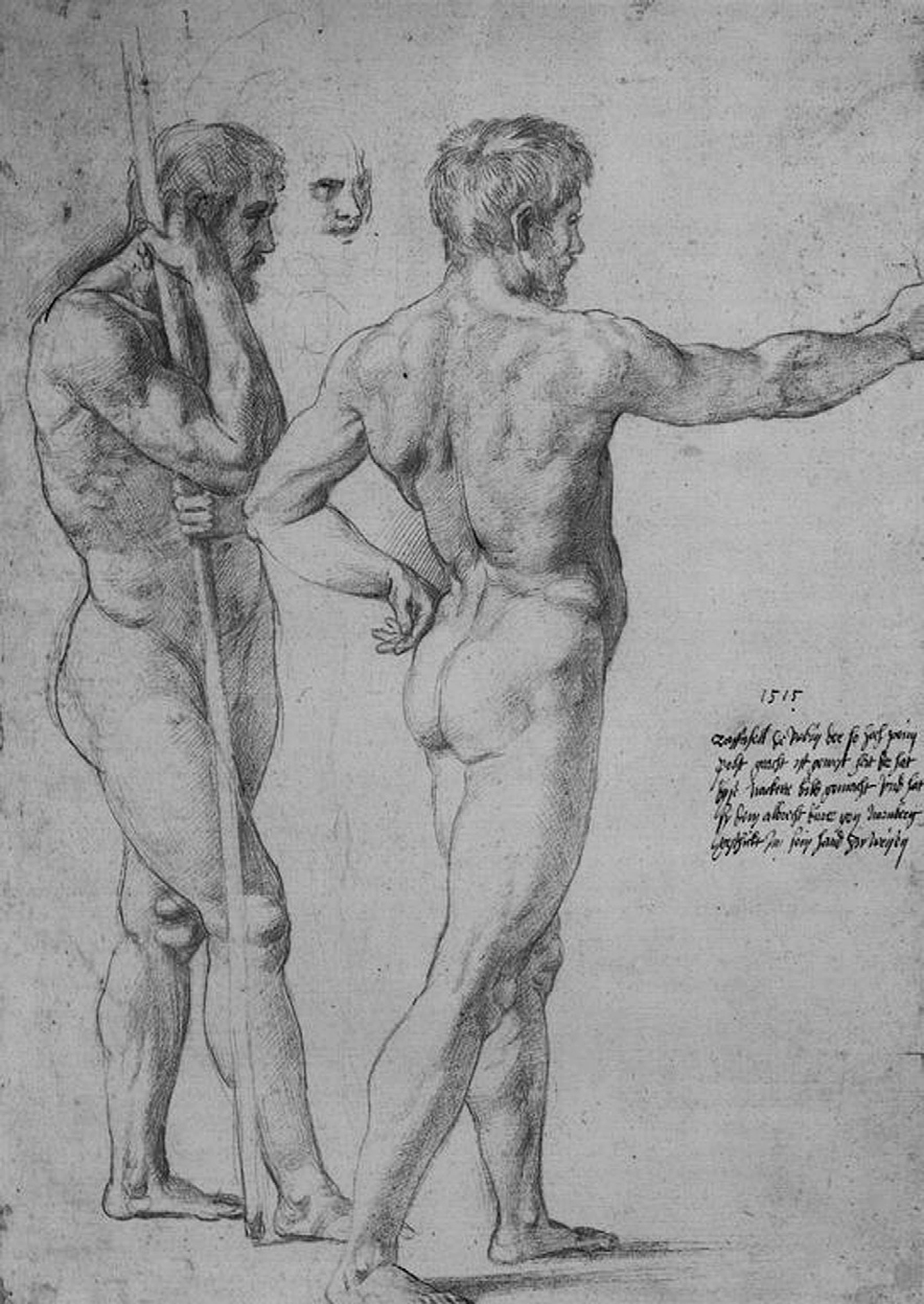
Figure 2 Raphael. Three Nude Men, ca. 1515. Red chalk drawing, with inscription by Albrecht Dürer, 1515. Vienna, Albertina.
Dürer annotated some of his own drawings and paintings, especially those that had personal significance. I shall return to the subject of self-collecting briefly later. Just as his inscription on Raphael's drawing binds together the two masters, texts join subject and artist in works such as Mein Agnes (fig. 3).Footnote 12 Whether consciously posed or surreptitiously sketched, his new wife's introspection is unprecedented in German art of this period: is she in deep thought or merely resting? Dürer captures the fleeting moment with a freshness that resonates with modern viewers. It anticipates Rembrandt's (1606–69) many drawings of his wife Saskia (1612–42). Other inscriptions are explicitly autobiographical. In a seminude self-portrait sketch the artist points to his side, possibly to his spleen, to document where he hurts.Footnote 13 The drawing records a personal moment that he could share with a physician or with friends. In typical fashion, and not just because he is using a mirror, Dürer seems to stare with unusual directness at the viewer in this extremely private image. As far as can be determined, Dürer retained this and most of his other self-portraits throughout his life.
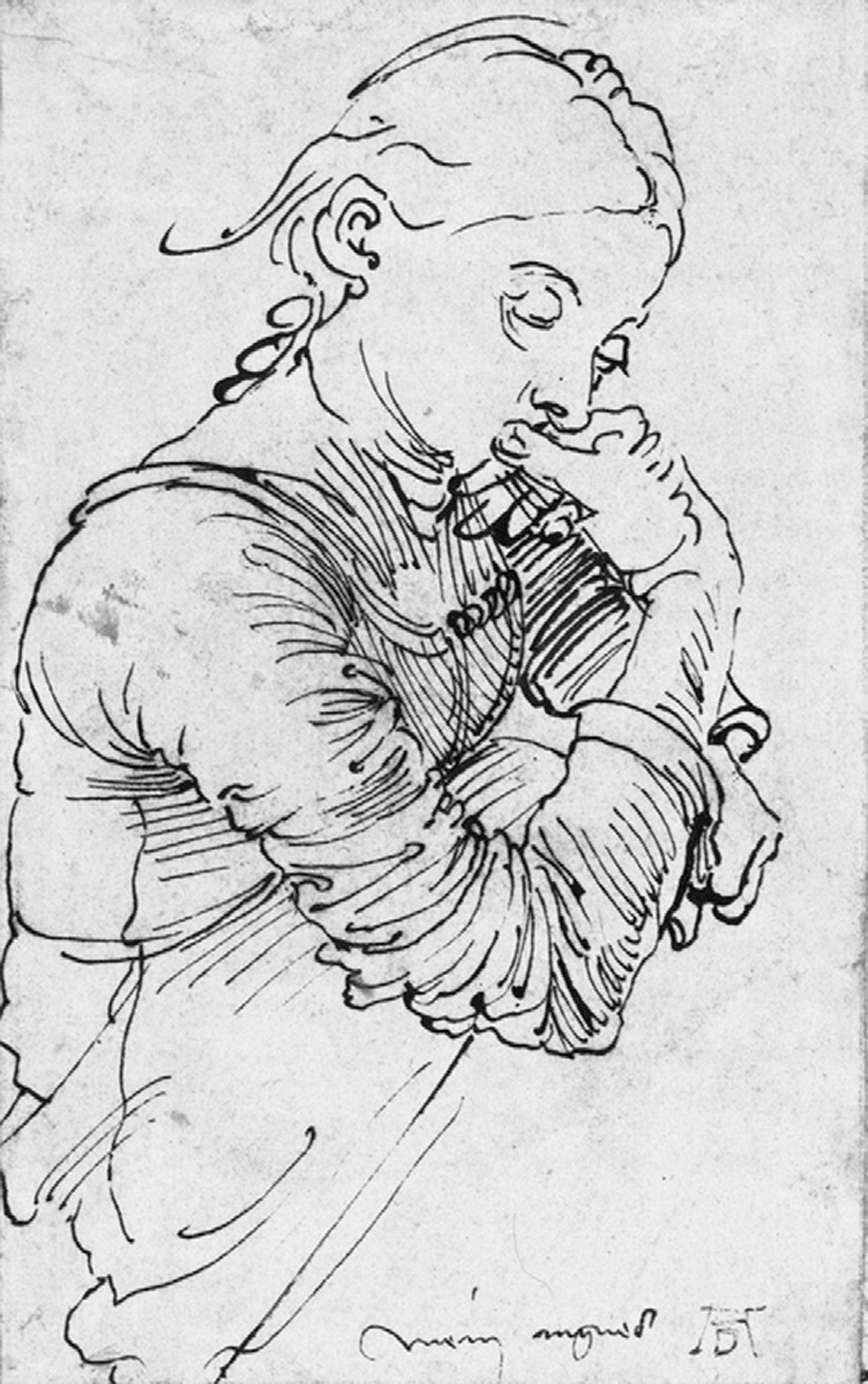
Figure 3 Albrecht Dürer. Mein Agnes (Portrait of Agnes Frey Dürer), ca. 1494. Pen and ink drawing. Vienna, Albertina.
In many cities young artists were expected to have a Wanderjahre, or period working as a journeyman abroad following the completion of their formal training. This sort of postgraduate study was intended to broaden the individual's exposure to new ideas and techniques. In 1490 young Albrecht headed to the Rhineland, specifically to Colmar, Basel, and Strasbourg.Footnote 14 If he hoped to learn from Martin Schongauer (ca. 1435/50–1491), Germany's most famous engraver and a skilled painter, he arrived sometime in 1492, well after the latter's death on 1 February 1491. Martin's brothers, however, aided Dürer.Footnote 15 Perhaps it was on this visit that he acquired the Lord Blessing (fig. 4).Footnote 16 The inscription, in Dürer's hand, reads “This was made by handsome Martin [Schongauer] in the year 1469.”Footnote 17 The Nuremberg artist likely also owned Schongauer's Christ as Judge — a drawing based on Rogier van der Weyden's (1399–1464) Last Judgment Altarpiece in the Hôtel Dieu in Beaune — and perhaps other sketches, as well as his prints.Footnote 18 Another large drawing by Schongauer that Dürer owned, depicting God the Father, the Virgin Mary, and saints set in a Gothic-style chapel, was last documented in 1786 in the Dresden collection of Karl Heinrich von Heinecken. It bore a text saying that handsome Martin had drawn it in 1470 when he was a young journeyman and that Albrecht Dürer, having learned this information, inscribed the drawing in Martin's honor in 1517.Footnote 19 Presumably, Dürer wanted to make sure that Schongauer's art was remembered. As Kemperdick notes, the tenor of the inscription suggests that Dürer only obtained this drawing in 1517 rather than during his Wanderjahre. Paul, the last surviving Schongauer brother, died in 1516, so it is possible that Dürer acquired it from his estate.Footnote 20 Dürer added identifying inscriptions to the Galloping Horseman made in 1484 by Wolfgang Beurer (active ca. 1480–ca. 1500), a Mainz painter.Footnote 21 At the bottom of the beautiful St. Sebastian (fig. 5) is the notation “Hans Traut [fl. 1488–1516] of Nuremberg made this” in Dürer's familiar handwriting.Footnote 22 How or whether it came into his possession is not clear, yet he felt compelled to add the name of a local painter whom he likely knew.
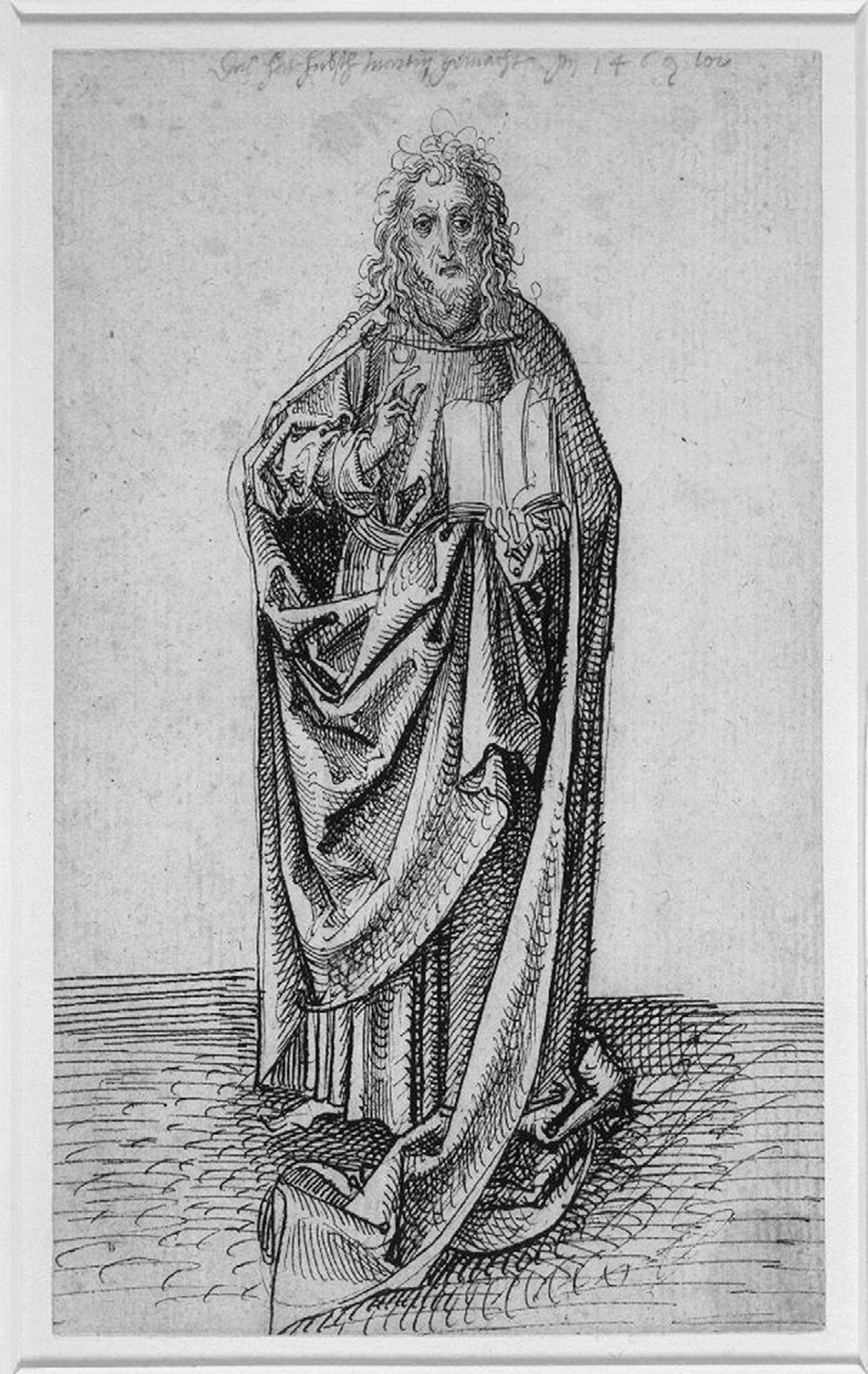
Figure 4 Martin Schongauer. Lord Blessing, ca. 1469. Pen and ink drawing, with inscription by Albrecht Dürer. London, British Museum. © Trustees of the British Museum.
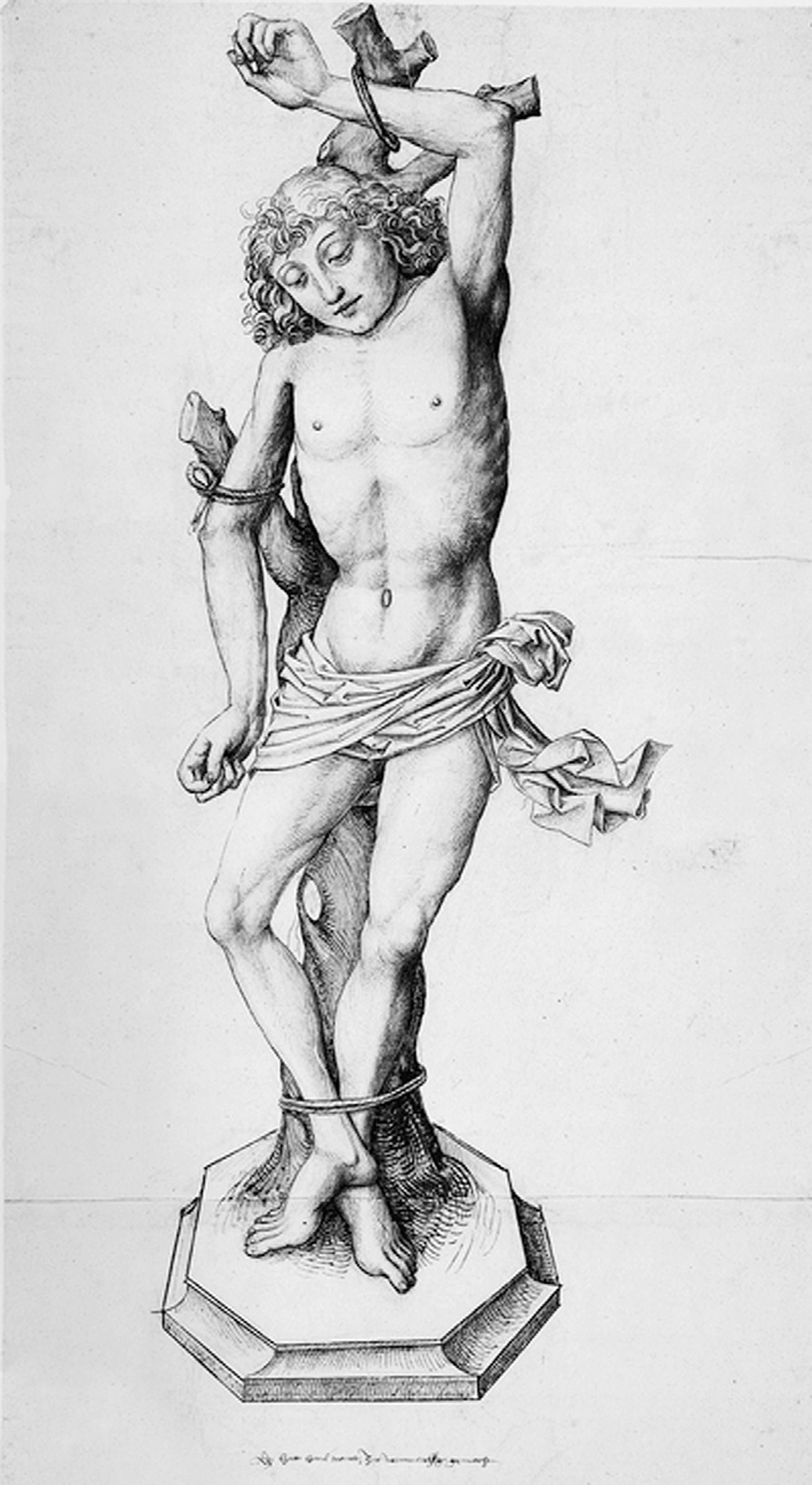
Figure 5 Hans Traut. St. Sebastian, ca. 1477–80. Pen and pencil with brown wash, with inscription by Albrecht Dürer. Erlangen, Universitätsbibliothek.
Dürer treated these drawings, excepting the lost Schongauer sheet, differently from the sketch by Raphael, since he did not append his own monogram or name to them. Yet this practice of identifying the artist and supplying a date has little precedent. Dürer was not even alive in 1469 when Schongauer supposedly created his Lord Blessing. Is this evidence of Dürer's historical awareness, something that he voiced more clearly in the 1510s and 1520s? Although he was not trying to write a history of art, he may have been organizing certain artists at fixed moments in time. Through the inscriptions on these and certainly other now-lost drawings, Dürer defined his connections, or his artistic lineage, with several major masters.Footnote 23 Collecting becomes a means of self-definition as a peer of these artists.
In 1494 Dürer carefully prepared a pen-and-ink drawing (fig. 6) after Andrea Mantegna's (1430/31–1506) Battle of the Sea Gods.Footnote 24 Copying is a standard method of mastering an artist's style.Footnote 25 These classicizing and highly sculpturesque figures fascinated Dürer, as he replicated each with exceptional care. By contrast, the surface details of the water and the reeds behind are only summarily approximated. Dürer monogrammed and dated his drawing, as he did the majority of his drawings even from the outset of his career. This was highly unusual in Germany at the time and, indeed, anywhere in Europe. Although the relationship between engraving and drawing are clear, one cannot prove that he actually owned the print. He could have borrowed Mantegna's print from a friend or from his teacher Michael Wolgemut (ca. 1437–1519) in Nuremberg or from someone in Northern Italy, or he could have purchased it during his first journey to Venice in 1494–95. One must make a distinction between works Dürer saw and those he clearly owned. Copying, however, is another form of collecting, as the artist consciously constructs a corpus of significant models.

Figure 6 Albrecht Dürer (after Andrea Mantegna). Battle of the Sea Gods, 1494. Pen and ink drawing. Vienna, Albertina.
Dürer was twice in Venice. The second trip occurred between the fall of 1505 and February 1507. One could assume that he, like a modern tourist, would have collected something there. Ten letters from this Venice period survive from Dürer to Willibald Pirckheimer (1470–1530), the famed Nuremberg humanist and the artist's best friend.Footnote 26 These are full of playful banter, such as the one in which Dürer employs little pictograms of a rose, a brush, and a running dog to inquire about Pirckheimer's lady friends.Footnote 27 The letters are replete with mention of items that he is purchasing or searching for on Pirckheimer's behalf, including books in Greek, Turkish carpets, Venetian glass, jewels, and rare bird feathers. Although Dürer mentions the paintings he is making, the jealousy of most Venetian artists, and a host of other topics, he is silent about any Italian art that he might have acquired. He writes only about clothing, specifically his French mantle and his Italian coat, both of which are given voices and in different letters send their respective greetings to Pirckheimer.Footnote 28 Dürer proudly wears one of his new fur-trimmed coats in the self-portrait that he inserted into his Feast of the Rose Garlands, which he painted for the German merchants’ church in Venice in 1506.Footnote 29 The clothing may also signal Dürer's social ambitions: he aspired to a higher class when he returned to Nuremberg, based on the status accorded to certain noted artists, such as Giovanni Bellini (1431/36–1516), in Venice.
It is highly unlikely that the artist really returned home empty-handed. He probably acquired prints and drawings. He mentions his friendly contacts with Giovanni Bellini, and that the famed Venetian artist wished to acquire something by him.Footnote 30 Perhaps the desire was reciprocal and reciprocated. Yet the only secure evidence comes from different sources. Dürer purchased books. On the title page of his copy of the Latin edition of Euclid's (fl. 300 bce) Opera, or Elements of Geometry (fig. 7), published in Venice in 1505, he penned, “This book I bought at Venice for a ducat in the year 1507 — Albrecht Dürer.”Footnote 31 He later owned a manuscript copy of the Elements of Geometry, which came from the estate of the famed mathematician and astronomer Johannes Müller von Königsberg, called Regiomontanus (1436–76), who lived in Nuremberg from 1471 to 1475.Footnote 32 Euclid's writings provided a solid grounding for Dürer's own theoretical studies of geometry, which culminated in the publication of his first treatise in 1525, the Unterweysung der Messung, mit dem Zirckel und Richtscheyt (Instruction in Measurement with a Compass and Rule).Footnote 33
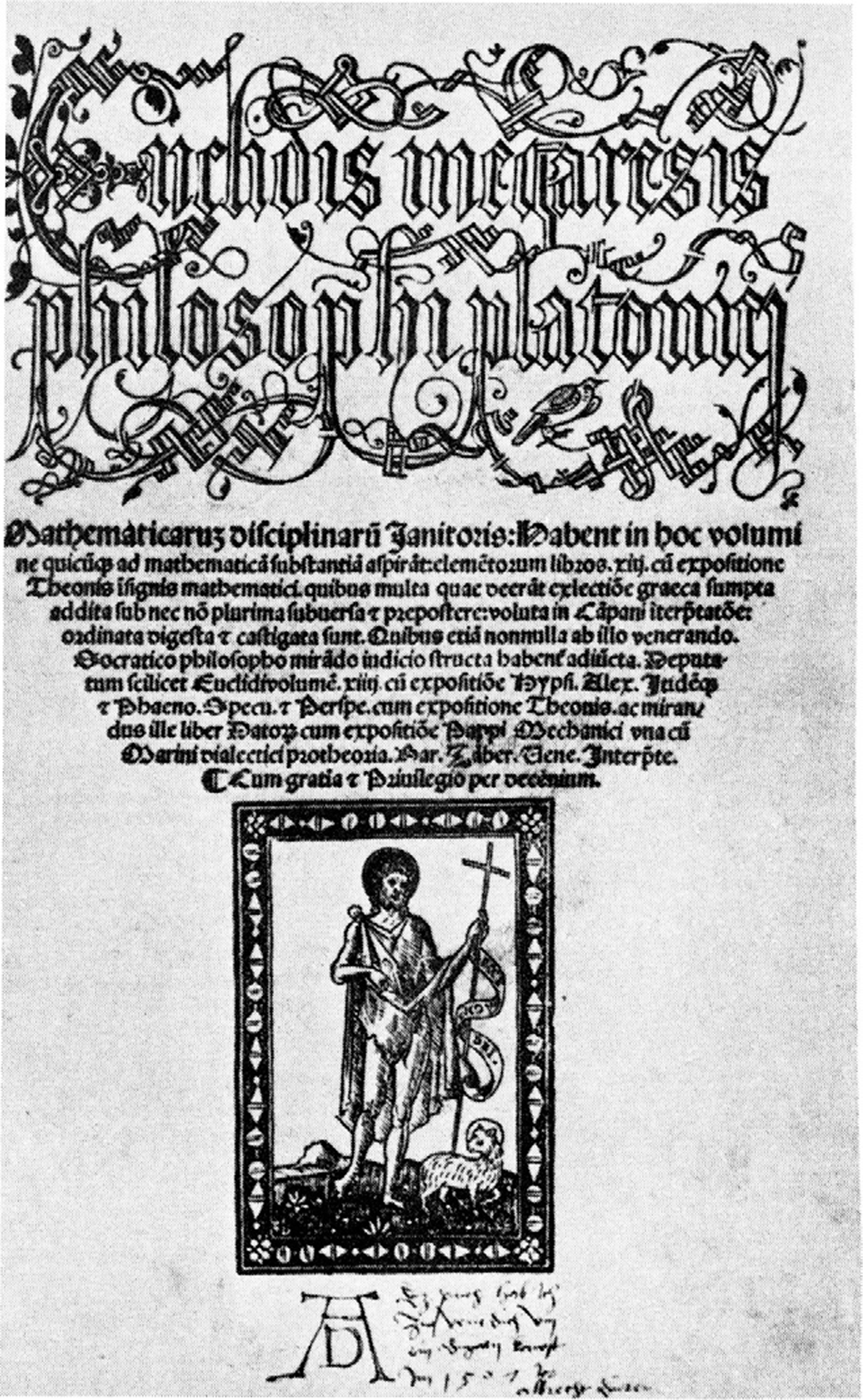
Figure 7 Title page of Euclid, Opera. Venice: Giovanni Tacuino, 1505. Title page with inscription by Albrecht Dürer recording his purchase in 1507. Wolfenbüttel, Herzog August Bibliothek, Rara A: 22.5 Geom. 2°.
Either in Venice or back in Nuremberg, Dürer obtained Francesco Colonna's (1433–1527) Hypnerotomachia Poliphili, which was published by Aldus Manutius the Elder (1449–1515) in Venice in 1499.Footnote 34 Manutius was a business associate of Anton Koberger (ca. 1445–1513), Nuremberg's leading publisher, who happened also to be Dürer's godfather. The woodcut illustrations, rather than the difficult language of this love story, most likely appealed to Dürer. At least one unsigned drawing by Dürer, depicting a table fountain, may have been inspired by the woodcuts of this book.Footnote 35 The volume ultimately passed from the possession of Dürer and his wife Agnes (1475–1539) to his youngest brother Endres (1486–1555), a goldsmith in Nuremberg who died in 1555, and then to Erasmus Flock (1514–68), a professor of mathematics in Wittenberg who later practiced medicine in Nuremberg.
In January 1523 Dürer purchased ten books from the estate of the mathematician and astronomer Bernhard Walther (ca. 1430–1504), whose house the artist had bought in 1509.Footnote 36 Unfortunately the Nuremberg document concerning the sale does not specify the individual titles. Walther owned a manuscript copy of Leon Battista Alberti's (1404–72) De Pictura, written in 1435–36 but only first printed in Basel in 1540. Dürer's own theoretical writings cite Piero della Francesca's (1415–92) then-unpublished De Prospectiva pingendi (ca. 1474) and, more extensively, the ancient Roman architect Vitruvius's (fl. late first century bce) De Architectura (Ten Books on Architecture), whose influence is already evident in Dürer's proportional designs well before the second trip to Venice.Footnote 37
Judging by his library, Dürer's favorite author was Martin Luther (1483–1546). From 1516 onward, the artist was a member of the Sodalitas Staupitziana, a small group that gathered at the local Augustinian monastery, at first to discuss the writings of Johann Staupitz (1460–1524), the general vicar of the Augustinian order in Germany and Luther's mentor. By 1519 Luther's own writings became the focus of the group, which renamed itself the Sodalitas Martiniana.Footnote 38 In about 1520 but prior to his Netherlandish trip, Dürer compiled a list of sixteen booklets by or about Luther that he owned.Footnote 39 These included Luther's Sermon on Indulgence and Grace of 1518, his text on the prayer Our Father for the laity of 1518/19, and perhaps the 1518 German translation of his Ninety-Five Theses. Most of these publications were relatively brief books or pamphlets.Footnote 40
While in the Low Countries in 1520–21, Dürer recorded purchasing or being given several new treatises, including the Condemnation of Luther, a Catholic response to Luther's writings by the theologians at the universities of Leuven (Louvain) and Cologne.Footnote 41 Cornelis Grapheus (1482–1558), Antwerp's city secretary, exchanged his copy of Luther's Babylonian Captivity for Dürer's Three Large Books (the Apocalypse, Large Passion, and Life of the Virgin) in 1521.Footnote 42 Dürer records paying a monk for binding two books that he purchased.Footnote 43 One wonders whether this bookbinder was an Augustinian and whether the tomes were by Luther, who remained an Augustinian monk until 1524. Not all of Dürer's new books were religious in theme.Footnote 44 Early in his trip he bought Pieter Gillis, called Petrus Aegidius (1486–1533), and Cornelius Grapheus's account of Charles V's (r. 1519–56) triumphal entry into Antwerp.Footnote 45 Dürer voiced his disappointment at being unable to obtain Jacopo de’ Barbari's (1469/70–1516) sketchbook of drawings from Margaret of Austria, regent of the Netherlands (r. 1507–15, 1519–30), when he visited her in Mechelen on 7 June 1521.Footnote 46 Dürer doubtlessly owned Andreas Bodenstein von Karlstadt's (1486–1541) pamphlet on the proper veneration of the sacrament of 1521 and certainly had Lazarus Spengler's (1479–1534) Ermahnung und Unterweisung zu einem tugendhaften Wandel (Admonition and Instruction to a Virtuous Transformation [Nuremberg, 1520]), both of which were dedicated to him.Footnote 47
Dürer's personal library contained at least thirty or forty books, and likely many more. In this count I include neither Dürer's own publications, such as his first two theoretical treatises, Unterweysung der Messung, mit dem Zirckel und Richtscheyt and Etliche underricht zu befestigung der Stett, Schlosz und flecken (Instruction on Fortifications [1527]), nor his books of prints, such as the Apocalypse, nor the fourteen books by Conrad Celtis (1459–1508) and other authors to which he contributed woodcuts.Footnote 48 We do not know what tomes he may have obtained from his father Albrecht Dürer the Elder (1427–1502); from his godfather, publisher Anton Koberger; from his teacher Wolgemut, who illustrated many books, including Hartmann Schedel's (1440–1514) Liber chronicarum (the Nuremberg Chronicle of 1493); and from his best friend Pirckheimer, a noted bibliophile.Footnote 49 Dürer's language skills were not limited to German: he possessed some facility with Latin and, less certainly, with Italian and perhaps Dutch. In his theoretical writings he stressed that young artists must learn to read and write, including in Latin.Footnote 50
Dürer, the era's greatest printmaker, collected woodcuts, engravings, drypoints, and etchings by his German contemporaries.Footnote 51 While in Antwerp he sold or exchanged prints in his possession by Hans Baldung Grien and Hans Schäufelein (1480/85–1540), younger artists who in the early 1500s had worked in Nuremberg.Footnote 52 His ownership of a particular impression of a specific print is documented only once. In 1519 or early 1520 Michael Ostendorfer (fl. 1520–49) created a large woodcut about the pilgrimage to the shrine of the Beautiful Virgin in Regensburg (fig. 8). The temporary wooden chapel, built in 1519 following the sudden expulsion of the city's long-established Jewish community, attracted hundreds of thousands of pilgrims between 1519 and 1525. Ostendorfer's woodcut illustrates the fervor of those seeking cures or intercession from Mary. Villagers carrying banners and giant candles proceed in a more orderly fashion around and into the chapel. Crutches, farm implements, and other votives hang from the porch, attesting to the site's efficacy. As more and more people flocked to Regensburg, stories of abuses, fake miracles, and economic exploitation circulated. On his impression of this print, Dürer penned a lament: “1523. This specter has arisen against the Holy Scripture in Regensburg and is permitted by the bishop because it is useful for now. God help us that we do not dishonor the worthy mother of Christ in this way but [honor] her in his name, Amen. Albrecht Dürer.”Footnote 53 A print of this scale would have been best stored in a large book or a folder.Footnote 54 Dürer may have initially acquired this woodcut for aesthetic or perhaps devotional reasons. At some point, however, from his increasingly Lutheran perspective, it came to evidence the gross abuses and dishonoring of the Virgin Mary condoned by Catholic Church officials.
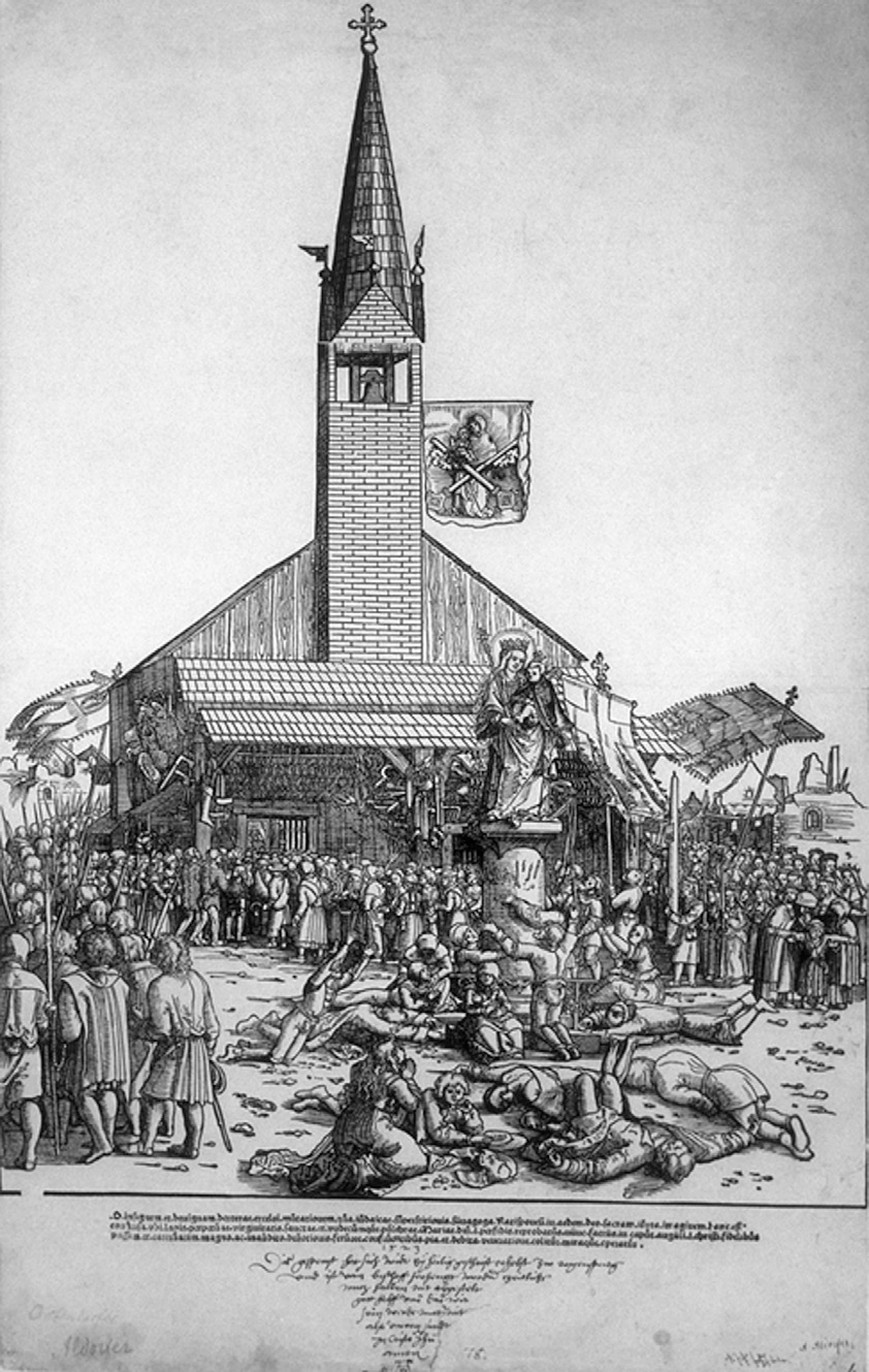
Figure 8 Michael Ostendorfer. Pilgrimage to the Shrine of the Beautiful Virgin of Regensburg, 1519–20. Woodcut with inscription by Albrecht Dürer, 1523. Kunstsammlungen der Veste Coburg/Germany.
The artist's journal of his Netherlandish trip is the richest source about his collecting.Footnote 55 Accompanied by his wife Agnes and a servant, Susanna (1502/06–62), he traveled to the Low Countries. The main purpose of the trip was to obtain from the new emperor, Charles V, a renewal of his annuity, which Emperor Maximilian I (r. 1493–1519) initially had awarded in 1515. Yet Dürer lingered for almost another eight months because of his love of travel, his curiosity, and perhaps also because of his frail health after having contracted malaria during his trip to Zeeland in December 1520. Dürer was fêted in every major town he visited. He wrote down details of his financial transactions, the names of those with whom he dined, and other observations. The entries for some days are lengthy, while occasionally there are weeks with scarcely a notation. Thus the journal provides a snapshot of his stay, rather than an inclusive picture. Still, no comparable text exists for any other Northern European artist at this time.Footnote 56
The journal is filled with references to his meetings with virtually every notable artist then active in the Low Countries, other than Quinten Massys (1466–1530), whose house he toured while the painter was presumably abroad; Jan Gossart; and Joos van Cleve (d. 1540/41). He enjoyed cordial relations with the landscape painter Joachim Patinir (ca. 1480–1524).Footnote 57 Dürer was even the guest of honor at Patinir's wedding. Dürer's recorded, but now lost, portrait of Patinir was apparently the source for Cornelis Cort's (1533–78) 1572 engraving of the artist.Footnote 58 He received Patinir's painting Lot and his Daughters Fleeing Sodom and Gomorrah (fig. 9) not from the artist, but from Adrian Herbouts, Antwerp's city syndicate.Footnote 59 Measuring just 22.5 x 29.7 centimeters, the picture is small enough for easy transport. Two angels guide the trio through a fantastic landscape as the cities behind burn. Lot's wife, now a pillar of salt, is but a white mark on the road behind them. The subsequent scene of the daughters seducing Lot occurs in the tent at the upper right.

Figure 9 Joachim Patinir. Lot and His Daughters Fleeing Sodom and Gomorrah, ca. 1521. Painting. Rotterdam, Museum Boijmans Van Beuningen.
Among the last artists Dürer met was Lucas van Leyden (ca. 1494–1533), whom we see in the Nuremberg master's silverpoint sketch (fig. 10).Footnote 60 The journal entries read, “Master Lucas who engraves in copper asked me to be his guest. He is a little man, born at Leyden in Holland; he was at Antwerp” and, later, “I gave 8 fl. of my prints for a whole set of Lucas's engravings.”Footnote 61 Lucas was the greatest of the current Netherlandish printmakers. Some of his engravings intentionally quote from and attempt to rival Dürer's prints. Eight florins was a considerable sum for prints. To put this into perspective, Dürer sold his Three Large Books (the Apocalypse, the Large Passion, and the Life of the Virgin) for six stuivers apiece or four for one florin, and his Engraved Passion for twelve stuivers or two for one florin.Footnote 62 Or put differently, the exchange was equal to at least forty-eight impressions of Dürer's famous Adam and Eve engraving of 1504. In today's market one or two good impressions of the Adam and Eve would have paid for the entire year's trip. In return Dürer received a significant quantity of Lucas's best prints.Footnote 63 This was one of the rare occasions on which Dürer acquired, or at least documented, his acquisition of works by his Netherlandish contemporaries.
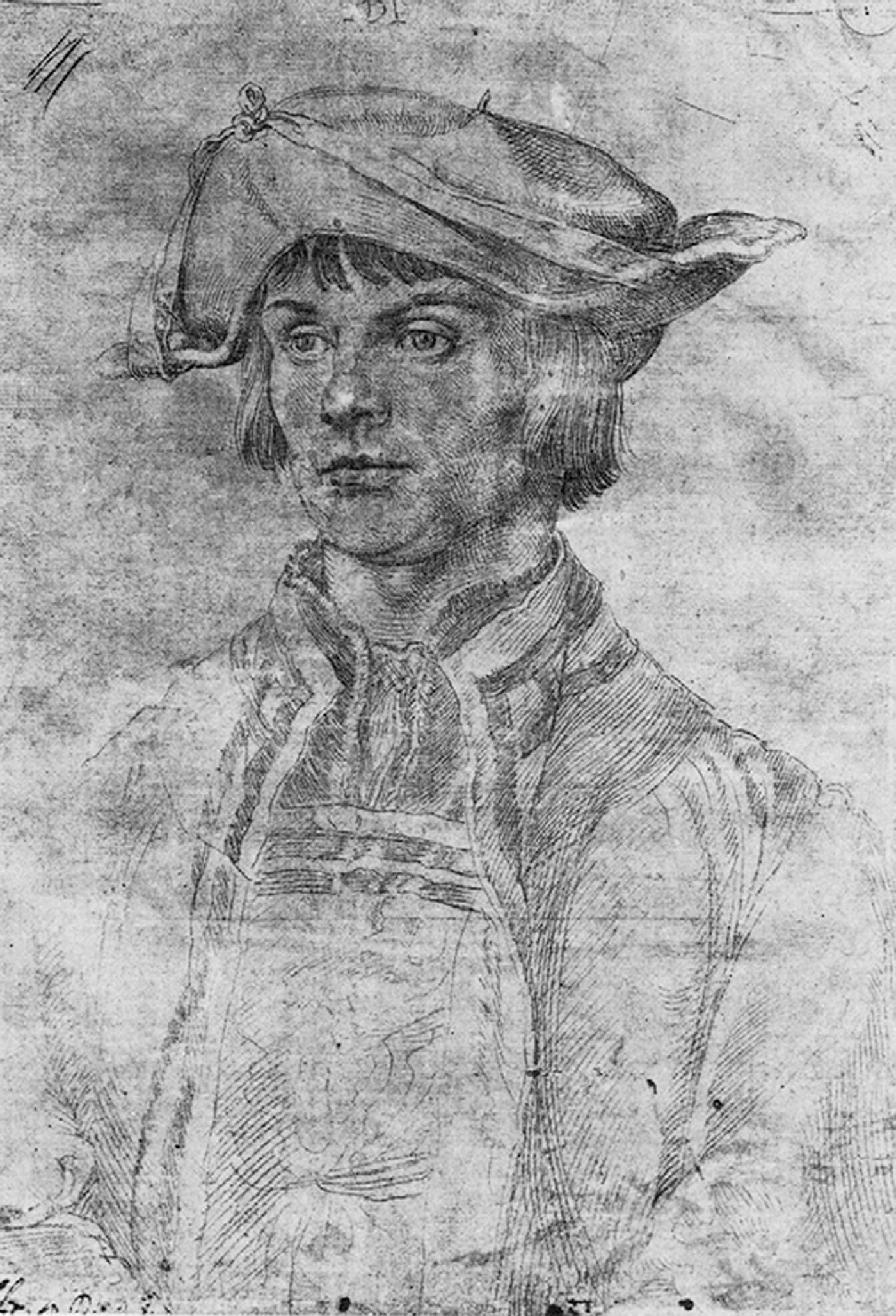
Figure 10 Albrecht Dürer. Portrait of Lucas van Leyden, 1521. Silverpoint drawing. Lille, Palais des Beaux-Arts.
Dürer obtained art through exchange or barter — as in the case of Lucas's prints — through purchases, and as gifts.Footnote 64 His activities are consistent with the prevailing gift economy in which social equals exchanged objects or services of roughly equivalent value. Gifts offered to a social superior were often done with the expectation of receiving something of higher value in return.Footnote 65 Dürer was stung when Margaret of Austria failed to reward him for his various gifts and when she disliked the portrait of her father Emperor Maximilian I, which he had hoped to present to her.Footnote 66 When artists invited him for a meal, he often reciprocated their generosity by sketching their portraits. Dürer lists receiving small gifts from artists, such as a pair of knives from the German sculptor Konrad Meit (fl. 1506–50/51) and some glass rosewater bottles for Agnes from the French sculptor Jean Mone (ca. 1485/90–1549[?]).Footnote 67 Sometimes he made a portrait or exchanged prints for objects that appealed to him, such as a cedar rosary, four silver medals, and a model of one of the ships of Ambrosius Höchstetter (d. 1534), an Augsburg merchant based in Antwerp who traded with the Portuguese.Footnote 68 The latter was either a high-quality wooden model or painting of the ship, for which the artist bought a special case.Footnote 69
Dürer did occasionally purchase items. He singles out a miniature by Susanna Horenbout, the eighteen-year-old daughter of Gerard Horenbout (or Horebout; before 1465–1541), a Ghent manuscript illuminator. Dürer writes, “She has illuminated a Salvator on a little sheet, for which I gave her one fl. It is very wonderful that a woman can do so much.”Footnote 70 He seems to have valued this mainly for its novelty. He bought the occasional print, including two Eulenspiegels and six Netherlandish cards, but he rarely provides sufficient detail to identify these today.
The third method of obtaining art was as a gift. Dürer records receiving a child's head on linen from Lorenz Sterck, treasurer to the provinces of Brabant and Antwerp, and three men's portraits, a gift from Erasmus (1467–1536), the famed humanist whom Dürer sketched twice during his stay in the Netherlands.Footnote 71 Thus his acquisition of art was often hardly systematic or even very suggestive about his aesthetic tastes.
Dürer seems to have been more interested in Italian art than in Netherlandish. There are journal entries for purchasing Italian art wares for three florins and Italian prints for eighteen stuivers.Footnote 72 He developed a close friendship with Tommaso Vincidor (fl. before 1517–34/36) of Bologna, one of Raphael's former assistants whom Pope Leo X sent to the southern Netherlands to design cartoons for tapestries to be woven in Brussels for the Sala di Constantino and Sala del Concisoro in the Vatican.Footnote 73 When Tommaso visited Dürer soon after the latter's arrival in Antwerp, he presented the German artist with, to cite the latter, “an antique gold ring with a very well-cut stone. It is worth five fl. but already I have been offered the double for it. I gave him six fl. worth of my best prints for it.”Footnote 74 In early October he wrote, “I gave Thomas of Bologna a whole set of prints to send for me to Rome to another painter who should send me Raphael's work in return.”Footnote 75 Whether Dürer ever received the promised work by Raphael is unknown. Raphael, who had died in 1520, continued to fascinate Dürer. Later journal entries note that Tommaso twice gave “an Italian work of art” to Dürer, who on a separate occasion purchased another Italian object.Footnote 76 Unfortunately, none of these items is identifiable today.
During his sojourn in the Netherlands, Dürer was exposed to artistic wares and other curiosities from the Americas, Africa, and southern Asia.Footnote 77 One of the most memorable and most famous passages from his journal records his awe at seeing the Aztec treasures brought to Europe in 1519 by Hernán Cortés (1485–1547) that were on display in the Coudenberg Palace in Brussels during his initial visit in late August 1520.Footnote 78 He writes, “I saw the things which have been brought to the king from the new land of gold, a sun all of gold a whole fathom broad, and a moon all of silver of the same size, also two rooms full of the armor of the people there, and all manner of wondrous weapons of theirs, harness and darts, very strange clothing, beds, and all kinds of wonderful objects of human use, much better worth seeing than prodigies. These things were all so precious that they are valued at 100,000 florins. All the days of my life I have seen nothing that rejoiced my heart so much as these things, for I saw among them wonderful works of art, and I marveled at the subtle Ingenia of men in foreign lands. Indeed I cannot express all that I thought there.”Footnote 79 Dürer pens the first written reaction to these items from the New World. An Aztec feathered shield from the booty of Cortés exemplifies the sorts of objects seen by the artist.Footnote 80 However, this may not have been Dürer's first contact, direct or indirect, with artifacts from the New World, since in one of his marginalia for the Prayer Book of Emperor Maximilian I (1515), he includes a fanciful depiction of a Brazilian Indian.Footnote 81 In this sketch, Dürer mistakenly turned a headdress (or cape) into a skirt. Later the artist may have encountered other items brought from the New World. While in Nuremberg on 12 January 1524, Martín de Peredes, chamberlain of Ferdinand I (1503–64), recorded that his master received from Emperor Charles V a marvelously worked cape with multicolored feathers and tiger fur lining. He claims that Montezuma (or Moctezuma; 1466–1520) wore this cape during pagan religious services in New Spain.Footnote 82
Vasco da Gama (ca. 1460/69–1524) and other Portuguese explorers had sailed around Africa and reached southwestern India by 1498.Footnote 83 Their traders imported large quantities of spices and other items back to Lisbon and to Antwerp, which in 1498 Manuel I, King of Portugal (r. 1495–1521), designated as the official distribution center for Northern Europe.Footnote 84 Soon after arriving in Antwerp, Dürer was hosted by Thomé Lopez, the Portuguese ambassador; João Brandão, the current factor, or royal trade representative; and Rodrigo Fernandez d'Almada, the factor's first secretary and himself the next factor. He had extensive interaction with all three men. Rodrigo, whom Dürer typically refers to by his first name, became one of the artist's closest friends and the source of several unusual, non-European gifts. On a single day in early April 1521, Dürer sketched Brandão's secretary in charcoal; Katharina, the factor's Moorish servant, in metalpoint; and Rodrigo in pencil and brush.Footnote 85 The portrait of Katharina is one of the finest studies of an African from this period.
Dürer's collection of exotica included numerous items from Calicut, a name used to refer to almost anything from Africa or southern Asia. The artist had some rudimentary familiarity with these lands explored by the Portuguese. In about 1506, a book entitled Den rechten weg ausz zu faren vo[n] Liszbona gen Kallakuth (The Correct Way to Travel from Lisbon to Calicut) was published in Nuremberg and doubtlessly discussed among local humanists and merchants.Footnote 86 Dürer was likely familiar as well with Hans Burgkmair's People of Africa and India (1508), an eight-block woodcut frieze with excerpts of Balthasar Springer's account of his journey around Africa to the Malabar Coast of India.Footnote 87 Springer, supported by the Welsers of Augsburg, accompanied Francisco Almeida's (ca. 1450–1510) mission of 1505–06 that created the first Portuguese viceroyalty in India. Although Dürer encountered art and artifacts from Africa and India while in Antwerp, he may have seen other items in South German collections.Footnote 88
The artist acquired most of his non-European possessions from acquaintances in Antwerp. If Dürer was inquisitive, Ambrosius Höchstetter, with whom he bartered for a portrait of his trading ship, was certainly an invaluable source of information about Africa and India. According to the humanist Konrad Peutinger (1465–1547), Höchstetter was one of at least three Augsburg patricians who purchased Indians, presumably as servants.Footnote 89 Lorenz Sterck gave Dürer a Calecutish wooden weapon, and Herr Gilbert, about whom nothing more is known, presented the artist with “a small Calicut target [shield] made of fish skin and two gloves with which the natives there fight.”Footnote 90 Dürer owned a prized lance.Footnote 91 Rodrigo gave Dürer two lengths of Calicut cloth, one woven in silk. Dürer records items such as an old Turkish whip, a printed Turkish cloth, and a piece of Moroccan leather.Footnote 92 In early September 1520, Brandão presented him with three pieces of parcolona (porcelain) and Rodrigo added some Calicut feathers.Footnote 93 Sterck gave him a nice piece of porcelain and an ivory whistle, which must have been of high value since Dürer reciprocated by giving him a “whole set of prints.”Footnote 94 Costly Asian imports, such as Chinese porcelain, increasingly were becoming available in major port cities like Antwerp.
In one of his most interesting entries, Dürer records, “I bought two ivory saltcellars from Calicut for 3 fl.”Footnote 95 Since the late fifteenth century, the Portuguese had commissioned and imported elaborate ivory saltcellars and eating utensils from the Sapi people living on the coast of Sierra Leone.Footnote 96 As seen in a beautiful contemporary example (fig. 11), these vessels typically have a flat-topped conical or cylindrical base ornamented with repetitive decorative patterns and rows of beads, central vertical supports sometimes alternating with human or animal figures, and, on top, a spherical lidded cup often with additional repeated, decorative markings as well as figures.Footnote 97 At a cost of three florins Dürer acquired attractive, but likely simpler, saltcellars. Yet it is difficult to know relative valuations. According to eighteen records of import duties paid by merchants bringing saltcellars into Portugal in 1504–05, these objects were relatively inexpensive.Footnote 98 They were assessed at less than the cost of a good linen shirt. Susan Vogel notes that Dürer's ivory saltcellars are the first documented examples recorded in Europe outside of Portugal.Footnote 99 Although these are referred to as saltcellars, their utility was as exotic table or sideboard decorations rather than as objects for practical, daily use.

Figure 11 Sapi-Portuguese artist(s). Saltcellar, ca. 1490–1530. Ivory. Rome, Museo Nazionale Preistorico e Etnografico. © S-MNPE “L. Pigorini,” Roma EUR — su concessione del Ministero per i Beni e le Attività Culturali.
Beyond the considerable quantities of clothing and fabric obtained during his travels, Dürer also acquired both naturalia, or interesting natural objects, and living creatures.Footnote 100 Through purchase, gift, or barter, he amassed several pieces of white coral; veined shells, most likely from outside Europe; a large tortoise shell, as well as several snail shells; a squid obtained either for its ink or, if dried, as a collectible; a great fish scale, fourteen fish skins, and several dried fish; a sprouting bulb; seeds from Italy; arrows made with cane shafts; thirteen brushes made of porpoise bristles (wild mehr schwein pörster); a musk ball, which then typically came from Central Asia; a little skull; two elk's hooves, one of which was valued highly at one gold florin; several ox, cow, and buffalo horns; and coconuts from India.Footnote 101 Several of the horns and one of the elk hooves ultimately were gifts for close friends in Nuremberg.Footnote 102 Willibald Pirckheimer received a costly inkstand made from a buffalo horn.Footnote 103 A good-sized horn also could be fashioned into a drinking vessel or into a wall decoration.Footnote 104 Recall that one of Pirckheimer's petty grievances against Agnes Dürer after the artist's death was her refusal to give him a prized set of stag antlers that he had coveted.Footnote 105 Rodrigo presented Dürer with Indian coconuts. Besides their exotic appearance, coconuts were sometimes carved and given goldsmith fittings, as seen in Melchior Baier (active 1525–77) and Peter Flötner's (1485/90–1546) Holzschuher drinking cup (fig. 12) with its bawdy scenes about drunkenness, which dates to around 1540.Footnote 106 Dürer also acquired a “magnetstain” (a magnetic or lodestone) for sixteen stuivers, an alabaster bowl, and, in the more sumptuous category, numerous jewels including an agate engraved with an image of Lucretia, a jacinth (a red transparent zircon), a ring made from buffalo, six precious stones, and three small rubies.Footnote 107 One expensive sapphire ring and two other rings were valued at fifty-four fl. and eight stuivers, or roughly the equivalent of 326 copies of Adam and Eve.Footnote 108

Figure 12 Melchior Baier and Peter Flötner. Holzschuher Cup, ca. 1540. Coconut with gilt-silver settings. Nuremberg, Germanisches Nationalmuseum.
Rodrigo, Dürer's Portuguese friend, gave the artist and his wife a small green parrot, then a second one, and, near the end of the stay in Antwerp, a third parrot listed as coming from Malaga.Footnote 109 Dürer purchased two cages for these. In mid-December, or about halfway through his trip, Dürer bought a little baboon for four gold florins.Footnote 110 The fate of this animal is unknown since it is not mentioned again. The artist depicted monkeys in several of his earlier works. In 1521 Dürer carefully portrayed a large baboon (fig. 13); however, since it appears together with a lynx, three lions, and a chamois, the animal was likely in the palace zoological garden in Brussels, which the artist visited at the end of his Netherlandish journey.Footnote 111

Figure 13 Albrecht Dürer. Sketches of Animals and Landscapes, 1521. Pen and ink drawing with blue, gray, and rose wash. Williamstown, Sterling and Francine Clark Art Institute. © Sterling and Francine Clark Art Institute, Williamstown, MA (photo by Michael Agee).
Dürer collected memories throughout his trip. These are obviously harder to quantify than objects. By recording his thoughts in the journal, he textually collected his experiences.Footnote 112 One example will illustrate this. About his visit to Ghent on 9 and 10 April 1521, he writes in part, “On my arrival in Ghent the Dean of the Painters came to me and brought with him the first masters in painting; they showed me great honor, received me most courteously, offered me their goodwill and service, and supped with me. On Wednesday they took me early to the Belfry of St. John whence I looked over the great wonderful town, yet in which even I had just been taken for something great. Then I saw Jan's picture; it is a most precious painting, full of thought, and the Eve, Mary, and God the Father are especially good. Next I saw the lions and drew one with metal-point.”Footnote 113 Looking over the city from the top of the tower of St. Jan's (fig. 14), Ghent's main church that was renamed St. Bavo's in 1559, he proudly reflected that the leading artists of this great city had just called him great. He remarks, albeit briefly, on Jan van Eyck's (ca. 1390–1441) Adoration of the Mystic Lamb of 1432, which is still housed in this church. Interestingly, the only thing he depicted was the live lion, which he drew in his silverpoint sketchbook.Footnote 114 This portable volume, which he refers to as mein Buchlein, contains drawings that record interesting sites or people that he encountered.Footnote 115

Figure 14 Hendricus Hondius. Plan of Ghent, detail of St. Bavo's Cathedral, 1641. Engraving.
As they sailed back up the Rhine near Boppard, Dürer portrayed his wife (fig. 15) in this sketchbook.Footnote 116 Even without knowing what Agnes might have purchased during the trip, it is clear that they returned to Nuremberg with much more than they had left with a year earlier: the journal records several shipments of bales and packing trunks being sent ahead to Nuremberg.Footnote 117 Dürer even prevailed upon Wenzeslaus Link (1483–1547), the vicar-general of the German congregation of the Augustinians, to transport some of the more fragile items. He writes, “I gave the new vicarius the great turtle shell, the fish shield, the long pipe, the long lance, the fish-fins, and the two little casks of lemons and capers to take home for me.”Footnote 118 Still other items accompanied Dürer, Agnes, and their maid Susanna as they headed home.
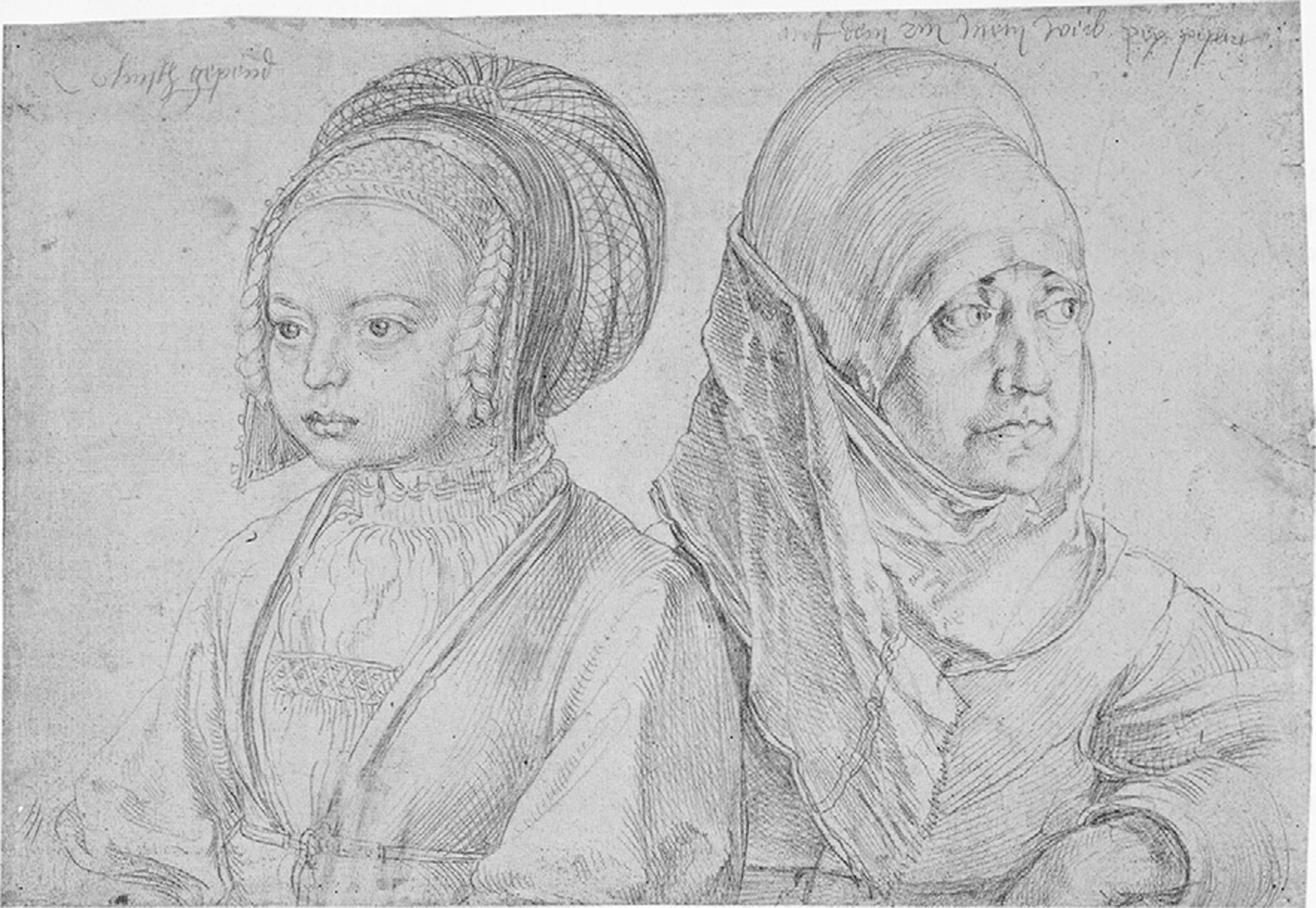
Figure 15 Albrecht Dürer. Portrait of Agnes Dürer and a Young Girl in Cologne Dress, 1521. Silverpoint drawing. Vienna, Albertina.
Dürer purchased his large house (fig. 16) opposite the Tiergärtnertor in Nuremberg in 1509.Footnote 119 Acquired in 1825 by the city of Nuremberg, it was used first by an art society, the Albrecht-Dürer-Verein; since 1871 it has been in the Albrecht-Dürer-Haus Museum. Architectural and archeological studies have yielded considerable information about the building and its history; however, the original functions of most rooms remain conjectural. The floor plans (fig. 17) show that the house had several large rooms with windows mainly on the north and west sides. The upper floors provided space for storing Dürer's own art, notably his stock of prints, their matrices, and his press, as well as room for his assistants to work. Efforts to decorate these rooms authentically, whether done in the nineteenth century or more recently, are evocative yet not based on historical documentation. Even longstanding features such as the bull's-eye windows were inspired by Dürer's engraving of St. Jerome in His Study (1514) rather than by archeological evidence. Nothing is known about how the artist adorned his house or how he displayed his prized possessions, for example, whether he concentrated his treasures in just one or two rooms, perhaps a studiolo or a Kunststube, or exhibited objects throughout the house.Footnote 120 Dürer possessed prints, drawings, and paintings by other artists; several of his own self-portraits and more personal paintings; a small library; beautiful and unusual natural objects such as shells and horns; and exotica from Calicut and other distant lands.

Figure 16 Albrecht Dürer House in Nuremberg, mainly fifteenth century. Reproduction © author.

Figure 17 Albrecht Dürer House in Nuremberg, floor plans sketched by Heinrich J. Dennemark, 1908. Courtesy of the Germanisches Nationalmuseum, Nuremberg.
Even gauged against the houses of Nuremberg's well-traveled and affluent patricians, Dürer's residence must have been quite exceptional. It was also a tangible argument supporting the higher social status to which Dürer had long aspired. What models did he have for exhibiting his treasures? While in the Low Countries, the Nuremberg artist toured Quentin Massys's house in Antwerp, which must have been richly embellished in order for it to be a local attraction.Footnote 121 Margaret of Austria guided Dürer through the public and private rooms, including the library, of her palace in Mechelen.Footnote 122 In Brussels, the artist visited the townhouse of Heinrich III, Count of Nassau (1483–1538), with its novelties, such as a meteorite and a bed large enough to sleep fifty guests, though he neglects to mention whether he saw there Hieronymus Bosch's (ca. 1450–1516) Garden of Earthly Delights (Madrid, Prado).Footnote 123 Dürer was familiar with the Nuremberg homes of Hartmann Schedel, Sebald Schreyer (1446–1520), Lazarus Spengler, Hieronymus Holzschuher (1469–1529), other patrician friends, and, above all, Pirckheimer.Footnote 124 Whether any of these residences or others, such as the houses of the Fuggers in Augsburg, inspired Dürer's own display choices is unknown.Footnote 125
The 1520s are too early to imagine coherently organized, encyclopedic art and wonder chambers of the sort that grew in popularity just a few decades later.Footnote 126 Dürer's holdings collectively suggested a range of natural and manmade wonders, some striking for their novelty and others admired for their artistry. There is, at the very least, a conceptual kinship between the artist's possessions and these later collections. His items, assembled in just a few rooms, offered a glimpse of the ever-expanding physical and cultural world of Dürer's time. The Rembrandthuis Museum in Amsterdam has attempted to reconstruct the appearance of the seventeenth-century Dutch master's studio, library, art, and wonder collections.Footnote 127 Although based on documentary sources, the display is hypothetical. Still, it provides another idea of how Dürer, on a more modest level, might have surrounded himself with his treasures.
There is one final category of collecting that I wish to touch upon briefly. Dürer self-collected. Most artists keep some of their own creations. We are sometimes better informed in Dürer's case because of the known provenances of his oeuvre, such as the portraits of his parents or his own self-portraits, and sometimes because of information that he himself provided. When he was a child Dürer portrayed himself in silverpoint (fig. 18).Footnote 128 The uniqueness of such a sketch is not the present concern here. Decades later, likely in 1522 or soon thereafter, Dürer annotated this drawing. The text reads, “Here I portrayed myself from a mirror in the year 1484, when I was still a child.”Footnote 129 Whether the drawing was initially saved through his parents’ or his own efforts matters less than that it was proudly kept. As a mature adult, Dürer added personal information, turning it into an accurate record. The inscription assumes intent, specifically that the Nuremberg master wanted others to recognize that he had been a child prodigy.

Figure 18 Albrecht Dürer. Self-Portrait, 1484. Silverpoint drawing. Vienna, Albertina.
As his own writings reveal, Dürer was preoccupied with the issue of enduring artistic fame. He cites Apelles (fl. late fourth–early third century bce) and Vitruvius, among others, who continue to be celebrated millennia after their deaths.Footnote 130 Dürer viewed his art, and equally his published theoretical treatises, as his legacy. Even texts added early in his career to works of art that remained in his collection suggest his autobiographical inclinations. The inscription on his Self-Portrait (Paris, Musée du Louvre) of 1493 notes, “My affairs go as ordained on high.”Footnote 131 It remains unclear whether this remark ruefully alludes to his being called from his journeyman's trip back to Nuremberg by his parents, who had arranged his marriage to Agnes Frey, or, alternatively, to his faith in God's guidance. After completing his moving sketch of the dead Christ and another drawing of a suffering man, both dated 1503, Dürer writes on the former, “These two faces I made in awe during my illness.”Footnote 132 His temporary physical suffering inspired him to create this poignant depiction of the suffering Christ.
Dürer's collection included portraits of his teachers, his parents, and his father-in-law.Footnote 133 He obviously retained affection for his master Michael Wolgemut (fig. 19), whom he painted in 1516, about twenty-seven years after leaving his shop. At the upper right he wrote, “Albrecht Dürer portrayed from life his teacher, Michael Wolgemut, in the year 1516.” Three years later Dürer added a second inscription, “and he was eighty-two years old and lived until 1519, when passed away on St. Andrew's day, before the sun came up.”Footnote 134 Dürer also possessed now-lost parchment portraits of an old man, described as his master in Strasbourg, and his wife, both painted in Strasbourg in 1494.Footnote 135 This information, presumably inscribed by Dürer on the pictures, documents his intentional autobiographical recordkeeping. Especially memorable is his charcoal sketch of his mother Barbara (1451–1514), on which he writes, “On March 19, this is Albrecht Dürer's mother when she was sixty-three years old.” A later inscription adds, “and she died in the year 1514 on Tuesday, the sixteenth of May, at two o'clock during the night.”Footnote 136 As in the case of Wolgemut, her exact date of death is listed in the second, later inscription. In both these works and in the drawing from Raphael, Dürer detachedly identifies himself in the third person. Dürer authored a watercolor on canvas depicting Hans Frey (1450–1523) on his deathbed.Footnote 137 Although now lost, this likeness had an inscription of some sort identifying the deceased as Dürer's father-in-law. The Nuremberg master documents his professional and family kinships perhaps as much for posterity as for the present.

Figure 19 Albrecht Dürer. Portrait of Michael Wolgemut, 1516. Oil on panel. Nuremberg, Germanisches Nationalmuseum.
If Dürer's intent was to preserve his memory, at least in part, through the art he collected, was he successful? His 1484 Self-Portrait was either inherited or acquired by Willibald Imhoff (1519–80), the Nuremberg collector.Footnote 138 In 1576, just a few years before Imhoff's heirs sold this drawing and most of his Dürers to Emperor Rudolf II (r. 1576–1612), Hans Hoffmann (ca. 1530–91/92) made a very careful brush-and-wash copy (fig. 20).Footnote 139 In clear brown ink, rendered with beautiful calligraphy, Hoffmann wrote, “On 4 February 1576 I made this portrait from the image drawn by the widely famed Albrecht Durrer inscribed in his own hand thus: This I drew myself from a mirror in the year 1484, when I myself was still a child. Albrecht Dürer.” In this last section Hoffmann loosely imitates Dürer's handwriting while replicating Dürer's original penned inscription. Another later hand added the text at top, which reads, “Albert Durer 14 Jar alt . . . im 1484.”Footnote 140 Dürer self-collected and, in turn, these works became avidly sought collectibles by others, such as Imhoff and Rudolf II, at the highest local and international levels.

Figure 20 Hans Hoffmann. Copy of the Self-Portrait of Albrecht Dürer, 1576. Brush and wash drawing. London, British Museum. © Trustees of the British Museum.
Collecting implies an audience, and presumably one larger than just Dürer and Agnes, who were childless. As someone who is known to have been highly sociable and who even discussed his dreams with his closest friends, Dürer doubtlessly entertained. Jan van Scorel (1495–1562), the Dutch painter, called on him in 1519.Footnote 141 Perhaps it was when Lucas Cranach the Elder visited Dürer's studio in 1524 that he made the silverpoint portrait of the Wittenberg master.Footnote 142 Even though there is little information about what he amassed during the majority of his career, he could at the very least proudly exhibit art by Schongauer, Raphael, Lucas van Leyden, Joachim Patinir, and other masters from several countries. He seems to have been drawn to novelties, such as the miniature by a woman artist, an ivory skull, and objects from exotic, distant lands. Such items might simply have commemorated a trip or were used to decorate his surroundings. Yet these could be valued too for their aesthetic merits, their rareness, as well as for what they might convey to others about Dürer's worldliness, knowledge, and inherent curiosity. One can even argue that his collection was another form of controlled self-portrait, one that Dürer could use to frame himself and express his social ambitions while also stimulating conversations with friends like Pirckheimer or Spengler. Dürer was not a systematic collector. Interestingly, little, if anything, acquired in the Low Countries inspired his own art of the 1520s. While incomplete, our knowledge of Dürer as collector offers new insights into the mature tastes and conscious self-fashioning of this renowned German master. One can only wonder how our assessments of Lucas Cranach the Elder and other German Renaissance artists might be enriched if we knew what they collected.
Appendix: Titles by Luther that Dürer Owned
Source: Rupprich, 1:221–22, no. 1, 3:447.
-
1. Resolutiones disputationum de indulgentiarum virtute (Wittenberg, 1518) or, alternatively, Kaspar Nützel's now-lost German translation of Luther's Ninety-Five Theses, published in 1518.
-
2. Ein Sermon von dem Ablass und Gnade (Wittenberg, 1518)
-
3. Ein Sermon von dem Bann (Wittenberg, 1520).
-
4. Die zehen Gebot Gottes mit einer kurzen Auslegung ihrer Erfüllung und Übertretung (Nuremberg, 1518).
-
5. Sermon de poenitentia (Wittenberg, 1518).
-
6. Ein Sermon von dem Sakrament der Buss (Wittenberg, 1519).
-
7. Ein sehr gute Predig von zweierlei Gerechtigkeit (Wittenberg, 1520; Latin edition, 1519).
-
8. Ein kurz Unterweisung, wie man beichten soll (Leipzig, 1519, published by Spalatin).
-
9. Ein gute trostlichhe Predig von der wirdigen Bereitung zu dem hochwirdigen Sakrament (Augsburg, 1518).
-
10. Ein Sermon von der Betrachtung des heiligen Leidens Christi (Wittenberg, 1519).
-
11. Ein Sermon von dem ehlichen Stand (Leipzig and Wittenberg, 1519).
-
12. Ein Sermon gepredigt zu Leipzig ufm Schloß . . . mit Entschuldigung etzlicher Artikel, so ihm von etzlichen seiner Abgunstigen zugemessen sein (Leipzig, 1519) or Ein Sendbrief und Verantwortung etzlicher Artikel (Wittenberg, 1523?).
-
13. Auslegung deutsch des Vaterunsers für die einfältigen Laien (Leipzig, 1519, or the 1518 edition of Johann Schneider).
-
14. Die sieben Bußpsalmen mit deutscher Auslegung nach dem schriftlichen Sinne (Wittenberg, 1517).
-
15. Auslegung des hundertundneuten Psalmen (Augsburg, 1518).
-
16. Disputatio et excusatio F. Martini Luther, adversus criminationes D. Johannis Eccii (Wittenberg, 1519) or Resolutiones Lutherianae super propositionibus suis Lipsiae disputatis (Wittenberg, 1519).






















